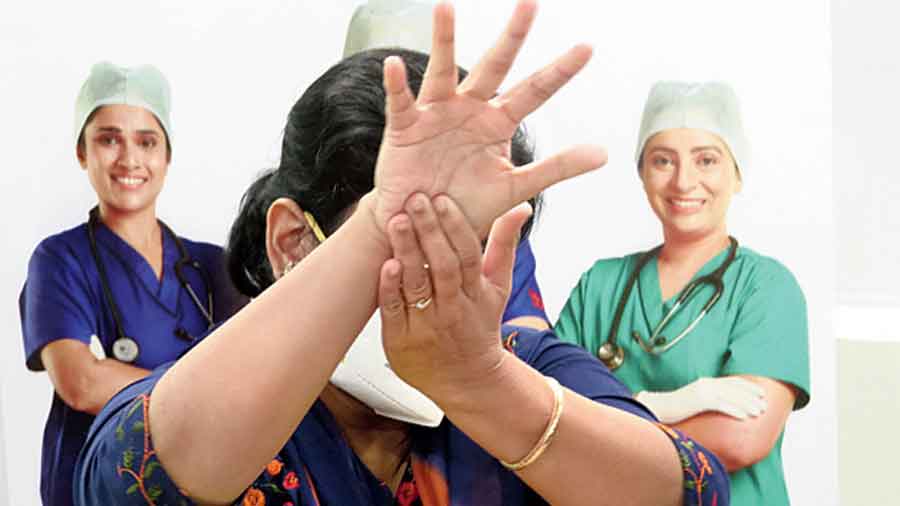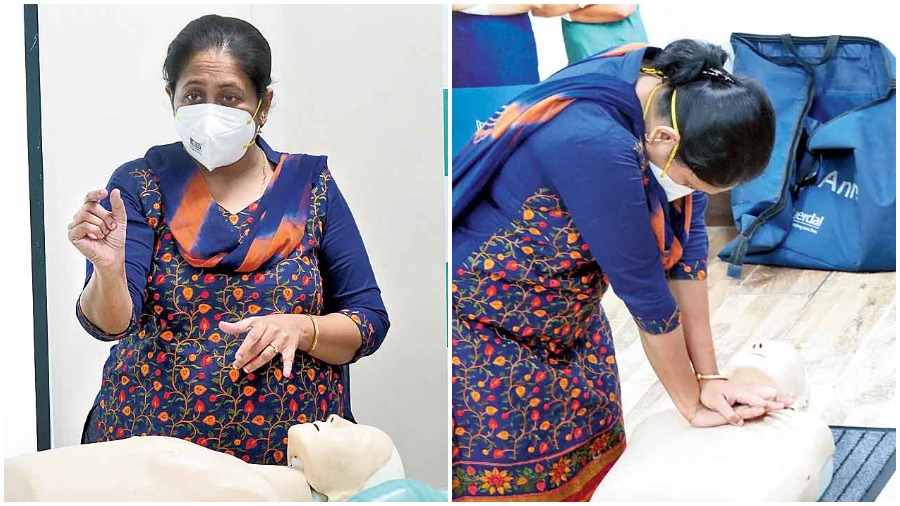Risk of Covid infection has reinforced an alteration in methods for imparting basic life support to people suspected to be suffering a cardiac arrest outside a medical set-up.
“Basic life support is a set of hands-on skills which, if propagated in the community, even lay persons not connected to the medical profession can do something to save a life until the victim can be given full medical support of a hospital. But in the current Covid situation, we do not advocate breathing into the mouth of a stranger. If it is someone in the family, then it is a different situation,” said Paramita Kanjilal Chakraborty, consultant, emergency medicine, at Manipal Hospital in IB Block. Covid spreads from person to person through small droplets from an infected person’s nose or mouth which are spread when he coughs or exhales, even from oral fluids or respiratory secretions.
Dr Kanjilal Chakraborty pointed out that even earlier there were risks in giving mouth-to-mouth resuscitation in a community setting. “There are other respiratory diseases that the person might have. In our country, tuberculosis infection is a factor. The person might also have blood-borne diseases, like hepatitis and HIV.” But the Covid pandemic, she stressed, had increased the risk manifold.
She was imparting a demonstration of basic life support skills at a workshop at Manipal Hospital.
But even without the breathing aid, she said, knowledge of cardio pulmonary resuscitation (CPR) method was a vital tool to save lives. “Research shows when a person has a cardiac arrest and the pump function of the heart stops, there is still some oxygen left in the blood. It takes some time for the oxygen level in the blood level to go down. The most important requirement is to circulate the oxygenated blood. You do not need to oxygenate the blood by breathing into his mouth as the aid provider also needs to be safe and not end up being a victim,” explained the resident of Akankha complex in New Town.
In a hospital, there are devices available, like a self-inflating ambu bag, to provide ventilation to a victim but it needs two trained people to use it. Without one, she advised her audience of non-medical listeners against using mouth-to-mouth resuscitation.

The doctor shows which part of the palm should be used for chest compression.
This is what she shared with the audience about the CPR technique:
A big number of sudden deaths occur due to cardiac causes — a heart attack in a layman’s language or there is something wrong with the heartbeat, beating fast or slow. In a cardiac emergency, the heart stops pumping properly. The most important organs that take a hit in that case are the brain, the heart itself and the kidneys. The purpose of basic life support is to work as artificial pump, send the blood to the peripheries so that the tissues remain oxygenated.
Basic life support does not require major equipment. You just need to know the skill.
Keep the person on a hard floor. The bed can have fancy cushions. So the floor is better.
When to apply basic life support
Scene safety: Ensure that basic life support is being given in a place that is safe. Life support cannot be given, say, in a building on fire. We have to evacuate first.

An Automated External Defibrillator
Check response: One has to tap and shout to find out if the person is okay. Even blinking or opening an eyelid is a kind of response. If the person is unresponsive. i.e. not responding to any external stimuli, call for help and get AED (Automated External Defibrillators) if available, then check for the pulse. Usually a physician checks the radial pulse, in the wrist. But in such a situation where the person is unresponsive, check the carotid pulse in the neck. This is closest to the heart and is a huge artery and so among the last parts of the body from where blood supply would vanish.
Locate the Adam’s apple, slide down to either side of the neck, find the groove and feel the pulse. Use the middle finger or the thumb to feel the pulse. Count 10. If there is a pulse you possibly would feel it within 10 seconds. Do not delay CPR beyond that. While you are checking the pulse, scan the chest and tummy to see if there is up-and-down movement to suggest breathing. The person could also be gasping, if he is on his last breath. This person needs CPR.
Where to place the hand when doing CPR
The most important part of CPR is chest compression. In order to do chest compression, the dominant hand is supposed to be placed on the lower one-third of the breast bone or the sternum. It corresponds to the nipple line. The upper parts are stiffer and would not go down easily. Only the heel of the hand of the person doing the compression should come in contact with the victim, and not the fingers or the rest of the hand as that might exert too much pressure and break the ribs. The chest wall is an elastic structure which can recoil, so the wall will come back to its original position after every compression when the pressure is released. The other hand should go beneath the dominant hand.
The logic is since the heart is placed inside the chest cavity, compressing the cavity would lead to compression of the heart.
The rate of compression should be 100 to 120 per minute. The depth of the compression should be five to six cm which comes to about one-third of the diameter of the chest wall, which can be estimated since the person would be lying on his back.
The compression has to be accompanied by ventilation, or breathing. So the CPR cycle is 30 compressions followed by two breaths. Five such sets complete a round of CPR. It takes typically two minutes to complete the cycle.
Only in case you are confident about not being at risk of infection from the victim, you might consider aiding him with ventilation. Pinch the victim’s nose close with your fingers, open the mouth and seal your mouth against the victim’s mouth so the victim’s mouth is inside your mouth and breathe twice normally and take your hands off the nose.
After a cycle, look again for the response — pulse and the up-and-down movement of the chest and the tummy. The person might get back his normal pulse. If not, and if there were two of you doing the CPR, it is time to switch tasks between ventilating and compressing as it is a very tiring job.
If even 75 to 80 per cent of the compression is correct, it might work.
The logic
Chest compression mimics the function of the heart to maintain circulation to the peripheral tissues, especially the vital organs like heart itself, kidneys and the brain. After each compression, the heart fills up with blood flowing in from the peripheries due to chest wall recoil.
Apply the AED (Automated External Defibrillator) and follow instructions as soon as they are available on the machine. A vital part of the CPR is the use of defibrillation to stop the abnormal electric activity in the heart.
How long to give CPR?
We, as professionals, take a call on how long we would continue depending on the cause of the cardiac arrest. In case of laymen, you need to continue until you get advanced medical care. But doing this job even for 20 minutes can be extremely strenuous.
